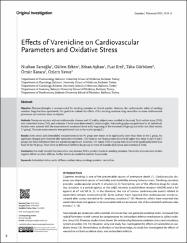| dc.contributor.author | Sarıoğlu, Nurhan | |
| dc.contributor.author | Erken, Gülten | |
| dc.contributor.author | Ayhan, Erkan | |
| dc.contributor.author | Erel, Fuat | |
| dc.contributor.author | Gürbüzer, Taha | |
| dc.contributor.author | Karaca, Ömür | |
| dc.contributor.author | Yavuz, Özlem | |
| dc.date.accessioned | 2019-09-30T10:11:02Z | |
| dc.date.available | 2019-09-30T10:11:02Z | |
| dc.date.issued | 2017 | en_US |
| dc.identifier.issn | 2148-3620 | |
| dc.identifier.issn | 2148-5402 | |
| dc.identifier.uri | https://doi.org/10.5152/ejp.2016.73644 | |
| dc.identifier.uri | https://hdl.handle.net/20.500.12462/6497 | |
| dc.description.abstract | "Objective: Pharmacotheraphy is recommended for smoking cessation in clinical practice. However, the cardiovascular safety of smoking cessation drugs has been questioned. Our goal is to evaluate the effects of the smoking cessation drug varenicline on some cardiovascular parameters and oxidative stress in subjects.
Methods: Twenty-six smokers without cardiovascular diseases and 25 healthy subjects were enrolled in the study. Total oxidant status (TOS), total antioxidant status (TAS), and urotensin II levels were determined in blood samples. Echocardiography was performed in all individuals. Smokers were assessed with the measurements mentioned above at the beginning of the treatment (V0 group) and at the end (third month, V3 group). The same measurements were performed once in the control group (C).
Results: Aortic strain and distensibility measurements in the V0 group were found to be significantly lower than those in the C group. No significant changes were observed after varenicline treatment. TOS values in the V0 group were found to be higher than those in the V3 and C groups, but these differences were not statistically significant. However, TAS values of the V3 group were found to be significantly lower than those of the V0 group. There were no differences between the groups in terms of diastolic dysfunction and urotensin II levels.
Conclusion: Our study revealed that varenicline may decrease TAS in smokers thanks to smoking cessation. Varenicline does not seem to have negative effects on aortic stiffness. Further studies are needed to confirm these results." | en_US |
| dc.description.sponsorship | "Balikesir University Research Funds BAP - 2012/100 BAP 2013/104 " | en_US |
| dc.language.iso | eng | en_US |
| dc.publisher | Wolters Kluwer Medknow Publications | en_US |
| dc.relation.isversionof | 10.5152/ejp.2016.73644 | en_US |
| dc.rights | info:eu-repo/semantics/openAccess | en_US |
| dc.rights | Attribution‐NonCommercial 3.0 United States | en_US |
| dc.rights.uri | http://creativecommons.org/licenses/by‐nc/3.0/us/ | en_US |
| dc.subject | Antioxidant Status | en_US |
| dc.subject | Aortic Stiffness | en_US |
| dc.subject | Oxidant Status | en_US |
| dc.subject | Smoking Cessation | en_US |
| dc.subject | Varenicline | en_US |
| dc.title | Effects of varenicline on cardiovascular parameters and oxidative stress | en_US |
| dc.type | article | en_US |
| dc.relation.journal | Eurasian Journal of Pulmonology | en_US |
| dc.contributor.department | Tıp Fakültesi | en_US |
| dc.contributor.authorID | 0000-0002-5180-9649 | en_US |
| dc.contributor.authorID | 0000-0002-5050-5694 | en_US |
| dc.contributor.authorID | 0000-0002-8218-8881 | en_US |
| dc.identifier.volume | 19 | en_US |
| dc.identifier.issue | 1 | en_US |
| dc.identifier.startpage | 8 | en_US |
| dc.identifier.endpage | 12 | en_US |
| dc.relation.publicationcategory | Makale - Uluslararası Hakemli Dergi - Kurum Öğretim Elemanı | en_US |



















